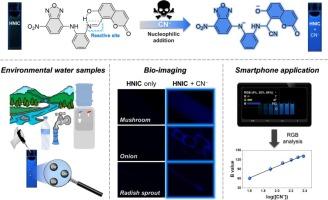An easily accessible fluorometric probe for selective cyanide detection via nucleophilic addition: Applications to environmental water samples, smartphone, and bio-imaging of fungi and plants
IF 4.7
2区 医学
Q1 BIOCHEMISTRY & MOLECULAR BIOLOGY
引用次数: 0
Abstract
The monitoring of cyanide (CN−) is of great significance due to its extreme toxicity to both humans and the environment. In this study, we report a convenient fluorescent sensor HNIC ((E)-7-hydroxy-8-(((2-((7-nitrobenzo[c][1,2,5]oxadiazol-4-yl)amino)phenyl)imino)methyl)-2H-chromen-2-one) for detecting CN−. On addition of CN−, HNIC exhibited a blue fluorescence turn-on response in aqueous media. Moreover, HNIC could selectively monitor CN− over other interfering ions, with a detection limit of 4.43 μM. The reaction of CN− with HNIC was evaluated using Job plot at a 1:1 ratio. To elucidate the mechanism of the nucleophilic attack of CN− on HNIC, ESI-MS analysis, 1H NMR titration, and DFT studies were employed. HNIC showed potential for quantifying CN− in environmental water samples (mineral, tap, river, and drinking water). Furthermore, a smartphone application utilizing HNIC successfully monitored CN− concentrations in environmental samples. Importantly, HNIC could track CN− through bio-imaging in fungi and plants, including white beech mushrooms, onions, and radish sprouts. Therefore, HNIC could be employed as a useful tool for detecting highly toxic CN− by triggering the fluorescent turn-on.

一种易于获取的荧光探针,用于通过亲核加成选择性氰化物检测:应用于环境水样,智能手机和真菌和植物的生物成像
氰化物(CN−)对人类和环境都具有极大的毒性,因此对其进行监测具有重要意义。在这项研究中,我们报道了一种用于检测CN−的便捷荧光传感器HNIC ((E)-7-羟基-8-((2-((7-硝基苯[c][1,2,5]恶二唑-4-基)氨基)苯基)亚胺)甲基)- 2h - chromen2 -one)。添加CN−后,HNIC在水介质中表现出蓝色荧光开启反应。此外,HNIC可以选择性地监测CN−而不是其他干扰离子,检测限为4.43 μM。用Job图以1:1的比例评价CN−与HNIC的反应。为了阐明CN−对HNIC的亲核攻击机制,采用ESI-MS分析、1H NMR滴定和DFT研究。HNIC显示了在环境水样(矿物、自来水、河流和饮用水)中量化CN−的潜力。此外,利用HNIC的智能手机应用程序成功地监测了环境样品中的CN -浓度。重要的是,HNIC可以通过真菌和植物的生物成像来追踪CN -,包括白山毛榉蘑菇、洋葱和萝卜芽。因此,HNIC可以作为一种有用的工具,通过触发荧光开关来检测高毒性的CN -。
本文章由计算机程序翻译,如有差异,请以英文原文为准。
求助全文
约1分钟内获得全文
求助全文
来源期刊

Bioorganic Chemistry
生物-生化与分子生物学
CiteScore
9.70
自引率
3.90%
发文量
679
审稿时长
31 days
期刊介绍:
Bioorganic Chemistry publishes research that addresses biological questions at the molecular level, using organic chemistry and principles of physical organic chemistry. The scope of the journal covers a range of topics at the organic chemistry-biology interface, including: enzyme catalysis, biotransformation and enzyme inhibition; nucleic acids chemistry; medicinal chemistry; natural product chemistry, natural product synthesis and natural product biosynthesis; antimicrobial agents; lipid and peptide chemistry; biophysical chemistry; biological probes; bio-orthogonal chemistry and biomimetic chemistry.
For manuscripts dealing with synthetic bioactive compounds, the Journal requires that the molecular target of the compounds described must be known, and must be demonstrated experimentally in the manuscript. For studies involving natural products, if the molecular target is unknown, some data beyond simple cell-based toxicity studies to provide insight into the mechanism of action is required. Studies supported by molecular docking are welcome, but must be supported by experimental data. The Journal does not consider manuscripts that are purely theoretical or computational in nature.
The Journal publishes regular articles, short communications and reviews. Reviews are normally invited by Editors or Editorial Board members. Authors of unsolicited reviews should first contact an Editor or Editorial Board member to determine whether the proposed article is within the scope of the Journal.
 求助内容:
求助内容: 应助结果提醒方式:
应助结果提醒方式:


